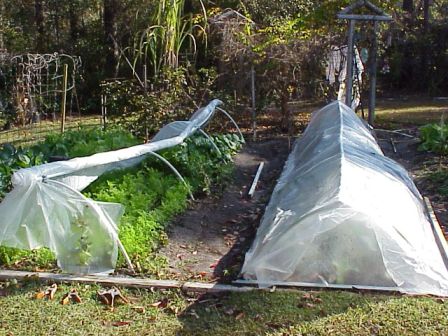
by Eddie Powell | Jan 22, 2015
Florida homeowners enjoy a wide range of landscape and citrus plants and often times desire a tropical or semitropical appearance to their landscapes. Many landscape plants are often planted past their northern limit such as here in Northwest Florida, although microclimates differ dramatically. Tropical and subtropical plants can be used in the landscape, but they must be protected or replaced if necessary during cold weather. A good variety of tender and hardy plants should be planted in order to prevent total devastation of the landscape by extremely cold weather.
The site selection for tender plants should be number one on your list when preparing for a freeze. Tender ornamental plants need a higher site with good air drainage, and not in a low area where cold air settles. Arranging tender plants along fences or other barriers to protect them from cold winds improves the plants’ cold protection, especially from very hard freezes.
Poorly drained soils result in weak shallow roots which are more susceptible to cold injury. Plants grown with the correctly applied rate of nutrients will tolerate colder temperatures better and recover from cold injury faster than plants grown with little or no added nutrients. Be aware that late fall fertilizing of nutrient deficient plants or fertilization before unseasonably warm periods can result in a late growth which is more susceptible to cold injury.
Ornamental plants that are planted under large tree canopies can have more cold protection and require less cold prevention for the owner.
Watering landscape plants before a freeze can help protect plants. A well watered soil will absorb more solar radiation than dry soil and will reradiate heat during the night by as much as 2°F . However, saturated soil conditions can damage the root systems of most plants over a few days, so make sure the ground is well drained.
Avoid late summer or early fall pruning which can alter the plant hormonal balance resulting a flush of new growth. This new growth is more susceptible to cold injury. Healthy plants are more resistant to cold than plants weakened by disease, insect damage, or nematode damage. Routine inspection for pests and implementation of necessary control measures are essential.
Here are a few methods for plant protection. Plants in pots or containers must be moved indoors where heat can be available to them. Containers that have to be left outdoors should be protected by mulches around the container or root ball of plants in the landscape to reduce heat loss from container sidewalls.
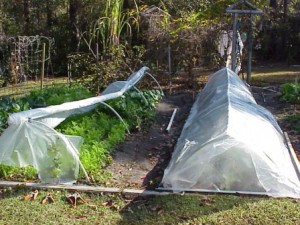
Cold Protection for Veggies!
Coverings can help protect plants more from frost than from extreme cold. Covers that extend to the ground and are not in contact with plant foliage can lessen cold injury to the plant. Foliage in contact with the cover is often cold burned or injured because of heat transfer from the foliage to the colder cover. Some examples of excellent plant covers are cloth sheets, quilts or black plastic. If plastic covering is used, it is extremely important to remove the covering during the day to provide ventilation of trapped heat. A light bulb under a covering also is a simple method of providing heat to ornamental plants in the landscape during the night hours. Cold Damage on Fruit Tree
Cold Damage on Fruit Tree
Pictures By Eddie Powell
Immediately after the frigid weather has passed, plants need to be checked for water loss. The foliage could be losing water vapor or transpiring on a sunny day after a freeze while water in the soil or container medium is frozen. Apply water to thaw the soil and provide available water for the plant. Soils or media with high soluble salts should not be allowed to dry out because salts would be concentrated into a small volume of water and can burn plant roots. Root burn can cause the roots to dry out and not take up water to the plant.
Pruning should be delayed until freezing temperatures have risen or until new growth appears to ensure that live wood is not removed. Dead, unsightly leaves may be removed as soon as they turn brown after a freeze if a high level of maintenance is desired. But it is best to wait until the threat of freezing weather is gone. Cold injury may appear as a lack of spring bud break on a portion or all of the plant, or as an overall weak appearance. Cold injury is usually found in the upper portion of the plant. Branch tips may be damaged while older wood underneath is free of injury. Cold injured wood can be identified by examining the cambium layer under the bark for black or brown coloration. Prune these branches back to a bud 2-3 inches behind the point of discoloration.
For more information on freeze protection of plants see:
Cold Protection of Landscape Plants
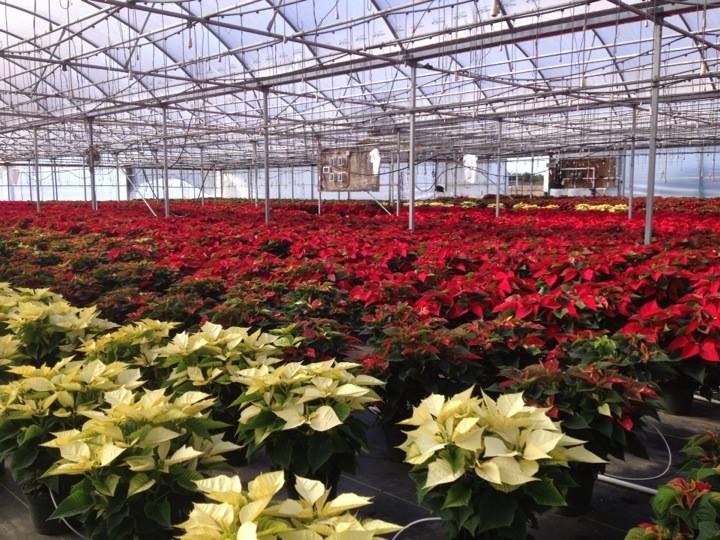
by Eddie Powell | Dec 9, 2014
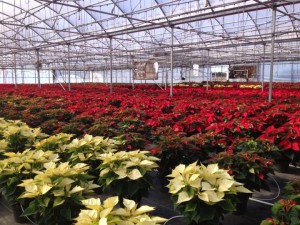
Poinsettia grown in greenhouse
Photo Credits: William Wendt
The poinsettia is a beautiful plant associated with the Christmas holidays. These plants create colorful holiday decorations for any home. After the holidays are over, they can be used as landscape plants.
Poinsettias are non-poisonous and non-toxic. However, some people may be sensitive to the latex in poinsettia sap. Although eating even a large number of leaves will not result in illness, the plant is not considered edible. When used as an indoor plant, it should be kept out of reach of children and pets.
Keep your poinsettias away from drafts and chilly air. Water your poinsettia when the surface of the soil is dry to the touch. Place a saucer under the pot, and drain the saucer if water starts to collect in it. Keep the soil from getting soggy. Gently spray the plants with a mist sprayer or place them on gravel trays. Slightly humid air will help prolong the plants’ color and life span. Do not fertilize your indoor poinsettias until you are ready to move them outside. High levels of fertilizer will reduce the quality of the plant.
When the temperatures start to warm up in spring, trim the fading bracts. Leave 4 to 6 inches of the stem on each branch. Begin using a well-balanced fertilizer, and move the plant outdoors to a somewhat shaded area. Once the poinsettia has acclimated to the outdoors, plant it in an area that receives full sun most of the day. Keep in mind that to put out its colorful bracts, poinsettias require 14 hours of complete darkness each day for 6 to 8 weeks. Any interruption to this dark period can delay or prevent the plant from flowering.
Keep the soil moderately moist at all times. Poinsettias grow best in moist, well drained, fertile soils. The ideal soil pH range is 5.5 to 6.5, but the plants will tolerate a range from 5.0 and 7.0. Fertilize your outdoor poinsettias once a month. In north Florida, the plants should be fertilized between May and September.
In the landscape, prune your poinsettias in early spring after they are finished blooming, and when the danger of frost has passed. Cut them back to within 12 to 18 inches of the ground. If the plants have been frozen below this point, cut them back to the live wood. Pruning during the growing season will produce a compact plant at flowering time. After four weeks or when the new growth is 12 inches long, cut the plant back, leaving four leaves on each shoot.
For more information see: Poinsettias at a Glance
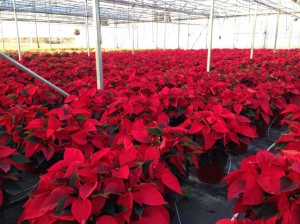
Poinsettia offers awesome Christmas color
Photo Credits: William Wendt

by Eddie Powell | Nov 17, 2014
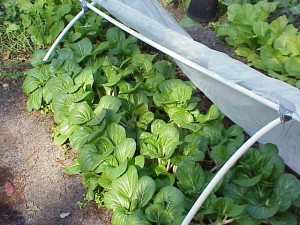
Northwest Florida homeowners enjoy growing their own vegetables every fall, but are faced with cold weather issues, especially during the first few days of December. For example, most cole crops can be planted until November, but they must be protected from the cold weather or they will need to be replaced. A good variety of cold tolerant plants should be used in order to prevent total devastation of the garden by extremely cold weather.
Below are a few tips to assist the home gardener in growing a successful winter vegetable crop.
- For tender plants, site selection should the top priority when preparing for a freeze. Vegetable plants need a site with good air drainage; not in a low area where cold air settles. Arranging tender plants along a barrier to protect them from cold winds improves the plants cold protection, especially from very hard freezes.
- Poorly drained soils result in weak and shallow roots which are more susceptible to cold injury.
- Plants grown with the correctly applied rate of nutrients will tolerate colder temperatures better and recover from cold injury faster than plants grown with little to no nutrients.
- Watering vegetable garden plants before a freeze can help protect plants. A well watered soil will absorb more solar radiation than dry soil and will radiate heat during the night. This may increase cold tolerance by as much as 2°F.
- Saturated soil conditions can damage the root systems of most plants over a few days, so make sure the ground is well-drained.
- Healthy vegetable plants are more resistant to cold than vegetable plants weakened by disease, insect damage, or nematode damage. Routine inspection for pests and implementation of necessary control measures are essential.
- Plastic or cloth coverings can help protect vegetable plants more from frost than from extreme cold. Covers that extend to the ground and are not in contact with the vegetable plants foliage will reduce cold injury. If the vegetable plant foliage is in contact with the cover it is often cold burned or injured because of heat transfer from the foliage to the colder cover. Some examples of excellent plant covers are cloth sheets, quilts or black plastic. If plastic covering is used, it is extremely important to remove the covering during the day to provide for ventilation of trapped heat.
- Feel free to contact your local county extension office for information on cold protection, pest identification and recommended control measures.

by Eddie Powell | Nov 11, 2014
Compost is partially decomposed organic matter or anything that was once a living plant. It is the product of controlled decomposition of organic materials by microorganisms. Humus is completely decomposed organic matter.
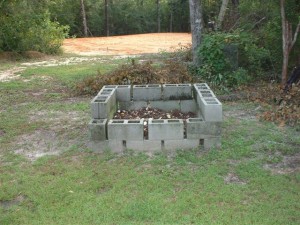
Concrete Block Compost Bin
Photo Credit : Eddie Powell
Green and brown materials with favorable proportions of carbon and nitrogen (C:N) (25:1) offer the microorganisms a “complete meal“. This helps the breakdown of the compost. Greens having high nitrogen and browns having high carbon.
“Green”
- High Nitrogen
- Fast to decompose
- Nitrogen provides the microbes with the raw element of proteins to build their bodies and reproduce.
Examples: manure, kitchen waste, grass clippings, inorganic nitrogen rich fertilizers.
“Brown”
- High Carbon
- Slow to decompose
- Carbon is the energy source for the microbes that help break down the materials.
Examples: leaves, wood chips, straw, sawdust.
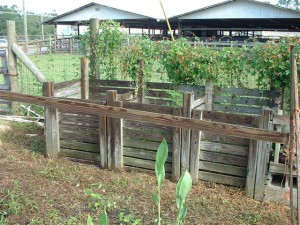
Wooden Compost Bin
Picture Credits : Eddie Powell
Layering in Compost Bin
The general rules for composting: 3 – 4″ layers alternating Green (high nitrogen) and Brown (high carbon) materials. Water each layer as you build it so material is moist not wet, like a wrung sponge. End with a Brown layer on top. Thin layers help prevent anaerobic (smelly) pockets from developing and allows microbes access to both Green and Brown food sources. Do not use meat (eggshells are OK) or dog / cat manure in your compost.
Make sure to filter your composting system because it may not break down all the larger materials, such as corncobs or wood chips.
When you screen your compost, any material larger than your screen size will be removed. The screened particles can be placed back in the compost bin to provide aeration. Additionally, the microbes attached to these pieces will help jump-start the new composting process.
For more information check out this site: Compost Tips for the Home Gardener.
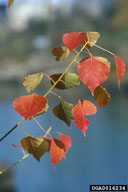
by Eddie Powell | Oct 7, 2014

Fall color of Chinese tallow. Image credit UGA Extension
Chinese tallow tree (Sapium sebiferum (L.) a deciduous and very aggressive tree. Many people appreciate the fact that it grows fast, provides great shade, and has a beautiful reddish fall color.
Despite it’s attributes, it is highly invasive and considered a noxious weed. It has spread to every coastal state from North Carolina to Texas, and inland to Arkansas. In Florida it occurs as far south as Tampa. Chinese tallow was listed in Florida as a noxious weed in 1998 which means that possession with the intent to sell, transport, or plant is illegal in the State of Florida.
The Chinese tallow tree can reach heights of 30 feet and the seeds resemble popcorn, hence its other name, popcorn tree. These popcorn shaped seeds and the aggressive root system sprouts make it very hard to control the spread of this tree. Animals also spread the seeds freely!
Although the Chinese tallow has great fall color problems come with it.
Some questions to ask yourself:
- Do you want great fall color and a yard full of Chinese tallow?
- Hey what about the neighbor. Do they want Chinese tallow in their yard?
Think about more than fall when planting.
To read more on how to control Chinese tallow follow this link: edis.ifas.ufl.edu/FR251


 Cold Damage on Fruit Tree
Cold Damage on Fruit Tree








